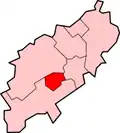South Northamptonshire (UK Parliament constituency)
South Northamptonshire is a constituency[n 1] represented in the House of Commons of the UK Parliament since its 2010 recreation by Andrea Leadsom, a Conservative who served as Secretary of State for Business, Energy and Industrial Strategy until 13 February 2020. She was Leader of the House of Commons from 2017 to 2019, and Secretary of State for Environment, Food and Rural Affairs from 2016 to 2017. [n 2] The seat of South Northamptonshire is considered a Conservative safe seat with having elected a Conservative MP at every election for 110 Years. Current Conservative MP Andrea Leadsom was re-elected in 2019 with an increased majority.
| South Northamptonshire | |
|---|---|
| County constituency for the House of Commons | |
 Boundary of South Northamptonshire in Northamptonshire for the 2010 general election | |
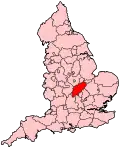 Location of Northamptonshire within England | |
| County | Northamptonshire |
| Electorate | 87,516 (2018)[1] |
| Major settlements | Brackley, King's Sutton, Towcester |
| Current constituency | |
| Created | 2010 |
| Member of Parliament | Andrea Leadsom (Conservative) |
| Number of members | One |
| Created from | Daventry |
| 1950–1974 | |
| Number of members | One |
| Replaced by | Daventry |
| Created from | Daventry and Kettering |
| 1832–1918 | |
| Number of members | 1832–1885: Two 1885–1918: One |
| Replaced by | Daventry |
History
Before 2010, the constituency existed from 1832–1918, and from 1950–1974, however on different boundaries during each period. It elected two Members of Parliament (MPs) by the bloc vote system of election from 1832, until the representation was reduced in 1885 to one member elected by the first past the post system.
- Prominent members
Three names feature prominently among the area's Commons members, the 3rd and 5th Earl Spencer (during their tenures as MP having a courtesy title only, Viscount Althorp – Althorp is a major country house in the seat, well known as the childhood home of Diana, Princess of Wales); Edward Fitzroy (son of Lord Southampton), Speaker of the House of Commons from 1928 until his death in 1943; and lastly, Reginald Manningham-Buller, 1st Viscount Dilhorne who on accomplishment of a peerage sat for the final two years of his life as the historic equivalent of the President of the Supreme Court of the United Kingdom with additional functions, the Lord Chancellor.
In the 19th century history of the seat the Cartwright family (with three members) lived in the stately home Aynhoe Park near Banbury.
- History of boundaries
The seat was abolished in 1918 to form the new constituency of Daventry, then recreated in 1950 caused by a relatively short-lived abolition of Daventry. In 1974 the constituency was almost wholly swallowed up by a reborn Daventry, which on wide boundaries saw substantial population growth.
This called for recreation in 2010 whereby most of the electoral wards were taken from the former version of the Daventry seat.
- Present bordering constituencies
The constituency is bordered by Daventry and Northampton South to the north, Wellingborough to the north east, Milton Keynes North and Milton Keynes South to the south east, Buckingham to the south, Banbury to the south west and Kenilworth and Southam to the west.
Boundaries
1832–1885: The Hundreds of Kings Sutton, Chipping Warden, Greens Norton, Cleley, Towcester, Fawsley, Wymersley, Spelhoe, Nobottle Grove, and Guilsborough.[2]
1885–1918: The Sessional Divisions of Brackley and Towcester, and part of the Sessional Division of Daventry.
1950–1974: The Boroughs of Daventry and Brackley, and the Rural Districts of Brackley, Daventry, Northampton, and Towcester.
2010–present: The District of South Northamptonshire wards of Astwell, Blakesley, Blisworth, Brackley East, Brackley South, Brackley West, Chase, Cogenhoe, Collingtree, Cosgrove, Courteenhall, Deanshanger, Grafton, Kings Sutton, Kingthorn, Little Brook, Middleton Cheney, Salcey, Silverstone, Steane, Tove, Towcester Brook, Towcester Mill, Wardoun, Washington, Whittlewood, and Yardley, and the Borough of Northampton wards of East Hunsbury, Nene Valley, and West Hunsbury.
Members of Parliament
MPs 1832–1885
| Election | 1st Member[3][4] | 1st Party | 2nd Member[3] | 2nd Party | ||
|---|---|---|---|---|---|---|
| 1832 | Viscount Althorp | Whig[5] | William Ralph Cartwright | Tory[5] | ||
| 1834 | Conservative[5] | |||||
| 1835 | Sir Charles Knightley, Bt | Conservative[6][5] | ||||
| 1846 by-election | Cpt. Richard Howard-Vyse[n 3] | Conservative | ||||
| 1852 | Rainald Knightley | Conservative | ||||
| 1857 | Viscount Althorp | Whig[7][8] | ||||
| 1858 by-election | Col. Henry Cartwright | Conservative | ||||
| 1868 | Fairfax Cartwright | Conservative | ||||
| 1881 by-election | Pickering Phipps | Conservative | ||||
| 1885 | Redistribution of Seats Act: reduced to one member | |||||
MPs 1885–1918
| Year | Member[3] | Party | |
|---|---|---|---|
| 1885 | Sir Rainald Knightley | Conservative | |
| 1892 | David Guthrie[n 4] | Liberal | |
| 1895 | Hon. Edward Douglas-Pennant | Conservative | |
| 1900 | Hon. Edward FitzRoy | Conservative | |
| 1906 | Archibald Grove | Liberal | |
| 1910 | Hon. Edward FitzRoy | Conservative | |
| 1917 | National Party | ||
| 1918 | Unionist | ||
| 1918 | Constituency abolished, but revived in 1950 | ||
MPs 1950–1974
| Election | Member[3] | Party | Notes | |
|---|---|---|---|---|
| 1950 | Reginald Manningham-Buller | Conservative | Resigned 1962 on being raised to the peerage | |
| 1962 by-election | Arthur Jones | Conservative | ||
| February 1974 | Constituency abolished, but revived in 2010 | |||
MPs since 2010
| Election | Member[3] | Party | |
|---|---|---|---|
| 2010 | Andrea Leadsom | Conservative | |
Elections
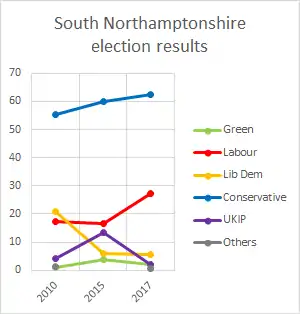
Elections in the 2010s
| Party | Candidate | Votes | % | ±% | |
|---|---|---|---|---|---|
| Conservative | Andrea Leadsom | 41,755 | 62.4 | -0.1 | |
| Labour | Gen Kitchen | 13,994 | 20.9 | -6.4 | |
| Liberal Democrats | Chris Lofts | 7,891 | 11.8 | +6.2 | |
| Green | Denise Donaldson | 2,634 | 3.9 | +1.8 | |
| Independent | Josh Phillips | 463 | 0.7 | +0.2 | |
| Independent | Stuart McCutcheon | 171 | 0.3 | N/A | |
| Majority | 27,761 | 41.5 | +6.3 | ||
| Turnout | 66,908 | 73.7 | -2.2 | ||
| Conservative hold | Swing | +3.15 | |||
| Party | Candidate | Votes | % | ±% | |
|---|---|---|---|---|---|
| Conservative | Andrea Leadsom[11] | 40,599 | 62.5 | +2.3 | |
| Labour | Sophie Johnson[12] | 17,759 | 27.3 | +10.6 | |
| Liberal Democrats | Chris Lofts[13] | 3,623 | 5.6 | -0.4 | |
| UKIP | Nigel Wickens | 1,363 | 2.1 | -11.4 | |
| Green | Denise Donaldson | 1,357 | 2.1 | -1.6 | |
| Independent | Josh Philips | 297 | 0.5 | N/A | |
| Majority | 22,840 | 35.2 | -8.2 | ||
| Turnout | 64,998 | 75.9 | +4.8 | ||
| Conservative hold | Swing | -4.15 | |||
| Party | Candidate | Votes | % | ±% | |
|---|---|---|---|---|---|
| Conservative | Andrea Leadsom | 36,607 | 60.1 | +4.9 | |
| Labour | Lucy Mills | 10,191 | 16.7 | -0.6 | |
| UKIP | Roger Clark | 8,204 | 13.5 | +9.5 | |
| Liberal Democrats | Tom Snowdon | 3,613 | 5.9 | -15.1 | |
| Green | Damon Boughen | 2,247 | 3.7 | +2.5 | |
| Majority | 26,416 | 43.4 | +9.2 | ||
| Turnout | 60,862 | 71.1 | -1.9 | ||
| Conservative hold | Swing | +2.75 | |||
| Party | Candidate | Votes | % | ±% | |
|---|---|---|---|---|---|
| Conservative | Andrea Leadsom | 33,081 | 55.2 | +3.7 | |
| Liberal Democrats | Scott Collins | 12,603 | 21.0 | +3.9 | |
| Labour | Matthew May | 10,380 | 17.3 | -11.4 | |
| UKIP | Barry Mahoney | 2,406 | 4.0 | +1.4 | |
| English Democrat | Tony Tappy | 735 | 1.2 | N/A | |
| Green | Marcus Rock | 685 | 1.1 | N/A | |
| Majority | 20,478 | 34.2 | N/A | ||
| Turnout | 59,890 | 73.0 | N/A | ||
| Conservative hold | Swing | +3.8 | |||
Elections in the 1970s
| Party | Candidate | Votes | % | ±% | |
|---|---|---|---|---|---|
| Conservative | Arthur Jones | 29,070 | 51.16 | ||
| Labour | Gordon J. Roberts | 21,131 | 37.18 | ||
| Liberal | C. A. Peter Smout | 6,626 | 11.66 | ||
| Majority | 7,939 | 13.97 | |||
| Turnout | 77.87 | ||||
| Conservative hold | Swing | ||||
Elections in the 1960s
| Party | Candidate | Votes | % | ±% | |
|---|---|---|---|---|---|
| Conservative | Arthur Jones | 25,023 | 52.84 | ||
| Labour | Graham T. Ridge | 22,332 | 47.16 | ||
| Majority | 2,691 | 5.68 | |||
| Turnout | 82.18 | ||||
| Conservative hold | Swing | ||||
| Party | Candidate | Votes | % | ±% | |
|---|---|---|---|---|---|
| Conservative | Arthur Jones | 24,823 | 54.27 | ||
| Labour | Ivor Wilde | 20,916 | 45.73 | ||
| Majority | 3,907 | 8.54 | |||
| Turnout | 83.04 | ||||
| Conservative hold | Swing | ||||
| Party | Candidate | Votes | % | ±% | |
|---|---|---|---|---|---|
| Conservative | Arthur Jones | 14,921 | 41.15 | -15.83 | |
| Labour | Ivor Wilde | 14,004 | 38.62 | -4.40 | |
| Liberal | N. Picarda | 7,002 | 19.31 | N/A | |
| Independent | P. Buchan | 332 | 0.9 | N/A | |
| Majority | 917 | 2.53 | -11.43 | ||
| Turnout | 36,259 | ||||
| Conservative hold | Swing | ||||
Elections in the 1950s
| Party | Candidate | Votes | % | ±% | |
|---|---|---|---|---|---|
| Conservative | Reginald Manningham-Buller | 24,226 | 56.98 | ||
| Labour | Arthur Richardson | 18,292 | 43.02 | ||
| Majority | 5,934 | 13.96 | |||
| Turnout | 82.72 | ||||
| Conservative hold | Swing | ||||
| Party | Candidate | Votes | % | ±% | |
|---|---|---|---|---|---|
| Conservative | Reginald Manningham-Buller | 21,497 | 55.35 | ||
| Labour | Ronald Lewis | 17,339 | 44.65 | ||
| Majority | 4,158 | 10.70 | |||
| Turnout | 81.56 | ||||
| Conservative hold | Swing | ||||
| Party | Candidate | Votes | % | ±% | |
|---|---|---|---|---|---|
| Conservative | Reginald Manningham-Buller | 21,282 | 53.59 | ||
| Labour | Dennis G. Webb | 18,434 | 46.41 | ||
| Majority | 2,848 | 7.18 | |||
| Turnout | 85.90 | ||||
| Conservative hold | Swing | ||||
| Party | Candidate | Votes | % | ±% | |
|---|---|---|---|---|---|
| Conservative | Reginald Manningham-Buller | 18,612 | 47.62 | n/a | |
| Labour | Dennis G. Webb | 16,852 | 43.12 | n/a | |
| Liberal | Llewellyn Evans | 3,620 | 9.26 | n/a | |
| Majority | 1,760 | 4.50 | n/a | ||
| Turnout | 87.10 | n/a | |||
| Conservative win | |||||
Election results 1868–1918
Elections in the 1860s
| Party | Candidate | Votes | % | ±% | |
|---|---|---|---|---|---|
| Conservative | Rainald Knightley | 2,522 | 34.4 | −0.3 | |
| Conservative | Fairfax Cartwright | 2,505 | 34.2 | +1.3 | |
| Liberal | Frederick John FitzRoy | 2,305 | 31.4 | −0.9 | |
| Majority | 200 | 2.8 | +2.2 | ||
| Turnout | 4,819 (est) | 76.0 (est) | −3.4 | ||
| Registered electors | 6,338 | ||||
| Conservative hold | Swing | +0.1 | |||
| Conservative hold | Swing | +0.9 | |||
Elections in the 1870s
| Party | Candidate | Votes | % | ±% | |
|---|---|---|---|---|---|
| Conservative | Fairfax Cartwright | Unopposed | |||
| Conservative | Rainald Knightley | Unopposed | |||
| Registered electors | 6,029 | ||||
| Conservative hold | |||||
| Conservative hold | |||||
Elections in the 1880s
| Party | Candidate | Votes | % | ±% | |
|---|---|---|---|---|---|
| Conservative | Fairfax Cartwright | Unopposed | |||
| Conservative | Rainald Knightley | Unopposed | |||
| Registered electors | 6,093 | ||||
| Conservative hold | |||||
| Conservative hold | |||||
Cartwright's death caused a by-election.
| Party | Candidate | Votes | % | ±% | |
|---|---|---|---|---|---|
| Conservative | Pickering Phipps | Unopposed | |||
| Registered electors | 6,093 | ||||
| Conservative hold | |||||
| Party | Candidate | Votes | % | ±% | |
|---|---|---|---|---|---|
| Conservative | Rainald Knightley | 4,074 | 50.4 | N/A | |
| Liberal | Maurice Fitzgerald | 4,012 | 49.6 | N/A | |
| Majority | 62 | 0.8 | N/A | ||
| Turnout | 8,086 | 83.9 | N/A | ||
| Registered electors | 9,636 | ||||
| Conservative hold | Swing | N/A | |||
| Party | Candidate | Votes | % | ±% | |
|---|---|---|---|---|---|
| Conservative | Rainald Knightley | 4,003 | 52.1 | +1.7 | |
| Liberal | James Carmichael | 3,687 | 47.9 | −1.7 | |
| Majority | 316 | 4.2 | +3.4 | ||
| Turnout | 7,690 | 79.8 | −4.1 | ||
| Registered electors | 9,636 | ||||
| Conservative hold | Swing | +1.7 | |||
Elections in the 1890s
| Party | Candidate | Votes | % | ±% | |
|---|---|---|---|---|---|
| Liberal | David Guthrie | 3,930 | 50.3 | +2.4 | |
| Conservative | Thomas Leslie-Melville-Cartwright | 3,882 | 49.7 | −2.4 | |
| Majority | 48 | 0.6 | N/A | ||
| Turnout | 7,812 | 84.4 | +4.6 | ||
| Registered electors | 9,251 | ||||
| Liberal gain from Conservative | Swing | +2.4 | |||
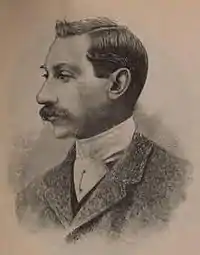
| Party | Candidate | Votes | % | ±% | |
|---|---|---|---|---|---|
| Conservative | Edward Douglas-Pennant | 4,553 | 57.8 | +8.1 | |
| Liberal | David Guthrie | 3,324 | 42.2 | −8.1 | |
| Majority | 1,229 | 15.6 | N/A | ||
| Turnout | 7,877 | 86.2 | +1.8 | ||
| Registered electors | 9,134 | ||||
| Conservative gain from Liberal | Swing | +8.1 | |||
Elections in the 1900s
| Party | Candidate | Votes | % | ±% | |
|---|---|---|---|---|---|
| Conservative | Edward FitzRoy | 4,174 | 56.9 | −0.9 | |
| Liberal | Archibald Grove | 3,166 | 43.1 | +0.9 | |
| Majority | 1,008 | 13.8 | −1.8 | ||
| Turnout | 7,340 | 81.8 | −4.4 | ||
| Registered electors | 8,976 | ||||
| Conservative hold | Swing | −0.9 | |||
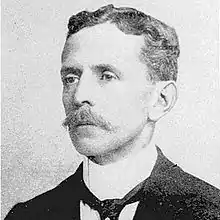
| Party | Candidate | Votes | % | ±% | |
|---|---|---|---|---|---|
| Liberal | Archibald Grove | 4,136 | 52.0 | +8.9 | |
| Conservative | Charles Douglas-Pennant | 3,814 | 48.0 | −8.9 | |
| Majority | 322 | 4.0 | N/A | ||
| Turnout | 7,950 | 88.1 | +6.3 | ||
| Registered electors | 9,023 | ||||
| Liberal gain from Conservative | Swing | +8.9 | |||
Elections in the 1910s
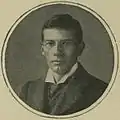
| Party | Candidate | Votes | % | ±% | |
|---|---|---|---|---|---|
| Conservative | Edward FitzRoy | 4,565 | 53.6 | +5.6 | |
| Liberal | Frederick Kellaway | 3,955 | 46.4 | −5.6 | |
| Majority | 610 | 7.2 | N/A | ||
| Turnout | 8,520 | 91.7 | +3.6 | ||
| Registered electors | 9,290 | ||||
| Conservative gain from Liberal | Swing | +5.6 | |||
| Party | Candidate | Votes | % | ±% | |
|---|---|---|---|---|---|
| Conservative | Edward FitzRoy | 4,340 | 53.1 | −0.5 | |
| Liberal | Arthur Augustus Thomas | 3,827 | 46.9 | +0.5 | |
| Majority | 513 | 6.2 | −1.0 | ||
| Turnout | 8,167 | 87.9 | −3.8 | ||
| Registered electors | 9,290 | ||||
| Conservative hold | Swing | −0.5 | |||
General Election 1914/15:
Another General Election was required to take place before the end of 1915. The political parties had been making preparations for an election to take place and by the July 1914, the following candidates had been selected;
- Unionist: Edward FitzRoy
- Liberal: Arthur Augustus Thomas[23]
Election results 1832–1868
Elections in the 1830s
| Party | Candidate | Votes | % | ||
|---|---|---|---|---|---|
| Tory | William Ralph Cartwright | Unopposed | |||
| Whig | John Spencer | Unopposed | |||
| Registered electors | 4,425 | ||||
| Tory win (new seat) | |||||
| Whig win (new seat) | |||||
| Party | Candidate | Votes | % | ||
|---|---|---|---|---|---|
| Conservative | William Ralph Cartwright | Unopposed | |||
| Conservative | Charles Knightley | Unopposed | |||
| Registered electors | 4,463 | ||||
| Conservative hold | |||||
| Conservative gain from Whig | |||||
| Party | Candidate | Votes | % | ||
|---|---|---|---|---|---|
| Conservative | William Ralph Cartwright | Unopposed | |||
| Conservative | Charles Knightley | Unopposed | |||
| Registered electors | 4,626 | ||||
| Conservative hold | |||||
| Conservative hold | |||||
Elections in the 1840s
| Party | Candidate | Votes | % | ±% | |
|---|---|---|---|---|---|
| Conservative | William Ralph Cartwright | 2,436 | 42.8 | N/A | |
| Conservative | Charles Knightley | 2,324 | 40.9 | N/A | |
| Whig | Henry FitzRoy | 925 | 16.3 | N/A | |
| Majority | 1,399 | 24.6 | N/A | ||
| Turnout | 3,305 (est) | 72.0 (est) | N/A | ||
| Registered electors | 4,589 | ||||
| Conservative hold | Swing | N/A | |||
| Conservative hold | Swing | N/A | |||
Cartwright resigned by accepting the office of Steward of the Chiltern Hundreds, causing a by-election.
| Party | Candidate | Votes | % | ±% | |
|---|---|---|---|---|---|
| Conservative | Richard Howard-Vyse | Unopposed | |||
| Conservative hold | |||||
| Party | Candidate | Votes | % | ±% | |
|---|---|---|---|---|---|
| Conservative | Charles Knightley | 2,272 | 39.2 | −1.7 | |
| Conservative | Richard Howard-Vyse | 2,064 | 35.6 | −7.2 | |
| Whig | Anthony Henley[24] | 1,460 | 25.2 | +8.9 | |
| Majority | 604 | 10.4 | −14.2 | ||
| Turnout | 3,628 (est) | 76.7 (est) | +4.7 | ||
| Registered electors | 4,729 | ||||
| Conservative hold | Swing | −3.1 | |||
| Conservative hold | Swing | −5.8 | |||
Elections in the 1850s
| Party | Candidate | Votes | % | ±% | |
|---|---|---|---|---|---|
| Conservative | Richard Howard-Vyse | 1,833 | 47.9 | +12.3 | |
| Conservative | Rainald Knightley | 1,833 | 47.9 | +8.7 | |
| Whig | John Houghton[25] | 164 | 4.3 | −20.9 | |
| Majority | 1,669 | 43.6 | +33.2 | ||
| Turnout | 1,997 (est) | 43.7 (est) | −33.0 | ||
| Registered electors | 4,568 | ||||
| Conservative hold | Swing | +11.4 | |||
| Conservative hold | Swing | +9.6 | |||
| Party | Candidate | Votes | % | ±% | |
|---|---|---|---|---|---|
| Whig | John Spencer | 2,107 | 37.4 | +33.1 | |
| Conservative | Rainald Knightley | 1,932 | 34.3 | −13.6 | |
| Conservative | Richard Howard-Vyse | 1,593 | 28.3 | −19.6 | |
| Majority | 175 | 3.1 | N/A | ||
| Turnout | 3,870 (est) | 82.8 (est) | +39.2 | ||
| Registered electors | 4,675 | ||||
| Whig gain from Conservative | Swing | +33.1 | |||
| Conservative hold | Swing | −15.1 | |||
Spencer succeeded to the peerage, becoming 5th Earl Spencer and causing a by-election.
| Party | Candidate | Votes | % | ±% | |
|---|---|---|---|---|---|
| Conservative | Henry Cartwright | 1,983 | 51.1 | −11.5 | |
| Whig | Anthony Henley[26] | 1,899 | 48.9 | +11.5 | |
| Majority | 84 | 2.2 | N/A | ||
| Turnout | 3,882 | 83.0 | +0.2 | ||
| Registered electors | 4,675 | ||||
| Conservative gain from Whig | Swing | −11.5 | |||
| Party | Candidate | Votes | % | ±% | |
|---|---|---|---|---|---|
| Conservative | Rainald Knightley | Unopposed | |||
| Conservative | Henry Cartwright | Unopposed | |||
| Registered electors | 4,955 | ||||
| Conservative hold | |||||
| Conservative gain from Liberal | |||||
Elections in the 1860s
| Party | Candidate | Votes | % | ±% | |
|---|---|---|---|---|---|
| Conservative | Rainald Knightley | 2,206 | 34.7 | N/A | |
| Conservative | Henry Cartwright | 2,092 | 32.9 | N/A | |
| Liberal | Frederick FitzRoy | 2,054 | 32.3 | N/A | |
| Majority | 38 | 0.6 | N/A | ||
| Turnout | 4,203 (est) | 79.4 (est) | N/A | ||
| Registered electors | 5,293 | ||||
| Conservative hold | Swing | N/A | |||
| Conservative hold | Swing | N/A | |||
Notes and references
- Notes
- A county constituency (for the purposes of election expenses and type of returning officer)
- As with all constituencies, the constituency elects one Member of Parliament (MP) by the first past the post system of election at least every five years.
- Later a member for Windsor: November 4, 1863 – July 11, 1865
- This source [9]
- References
- "England Parliamentary electorates 2010-2018". Boundary Commission for England. Retrieved 23 March 2019.
- "The statutes of the United Kingdom of Great Britain and Ireland. 2 & 3 William IV. Cap. LXIV. An Act to settle and describe the Divisions of Counties, and the Limits of Cities and Boroughs, in England and Wales, in so far as respects the Election of Members to serve in Parliament". London: His Majesty's statute and law printers. 1832. pp. 300–383. Retrieved 23 May 2020.
- Leigh Rayment's Historical List of MPs – Constituencies beginning with "N" (part 3)
- "Northamptonshire Southern 1832-1918 (Hansard)". hansard.millbanksystems.com.
- Stooks Smith, Henry. (1973) [1844-1850]. Craig, F. W. S. (ed.). The Parliaments of England (2nd ed.). Chichester: Parliamentary Research Services. pp. 232–233. ISBN 0-900178-13-2.
- Millbank Systems – reference to government on the opposition benches, July 1836
Note that at this time party affiliations were only beginning to become more rigid. - "Lincolnshire Chronicle". 10 April 1857. p. 2. Retrieved 11 August 2018 – via British Newspaper Archive.
- "Bell's Weekly Messenger". 4 April 1857. p. 1. Retrieved 11 August 2018 – via British Newspaper Archive.
- Hansard at Millbank Systems has no debates from November–December 1892 but from this source it seems David Guthrie never spoke in Parliament.
- "Northamptonshire South Parliamentary constituency". BBC News. BBC. Retrieved 22 November 2019.
- Leadsom, Andrea [@andrealeadsom] (28 April 2017). "Delighted and honoured to be readopted as Conservative candidate for South Northamptonshire this evening! #GE2017pic.twitter.com/5JqJfH8nu6" (Tweet) – via Twitter.
- "General Election". southnorthantslabour.com.
- http://www.libdems.org.uk/ (25 January 2017). "Chris Lofts".
- "Election Data 2015". Electoral Calculus. Archived from the original on 17 October 2015. Retrieved 17 October 2015.
- Statement of Persons Nominated, South Northamptonshire Council
- "BBC News - Election 2010 - Constituency - Northamptonshire South". news.bbc.co.uk.
- Craig, F. W. S., ed. (1977). British Parliamentary Election Results 1832-1885 (e-book)
|format=requires|url=(help) (1st ed.). London: Macmillan Press. ISBN 978-1-349-02349-3. - Craig, FWS, ed. (1974). British Parliamentary Election Results: 1885-1918. London: Macmillan Press. ISBN 9781349022984.
- The Liberal Year Book, 1907
- Debrett's House of Commons & Judicial Bench, 1886
- Debrett's House of Commons & Judicial Bench, 1901
- Debrett's House of Commons & Judicial Bench, 1916
- Northampton Mercury 10 Apr 1914
- "Which is the Low Party?". Northampton Mercury. 7 August 1847. p. 1. Retrieved 17 May 2019 – via British Newspaper Archive.
- "Oxford Chronicle and Reading Gazette". 17 July 1852. p. 3. Retrieved 11 August 2018 – via British Newspaper Archive.
- "The Parliament". London Evening Standard. 3 February 1858. p. 3. Retrieved 11 August 2018 – via British Newspaper Archive.
